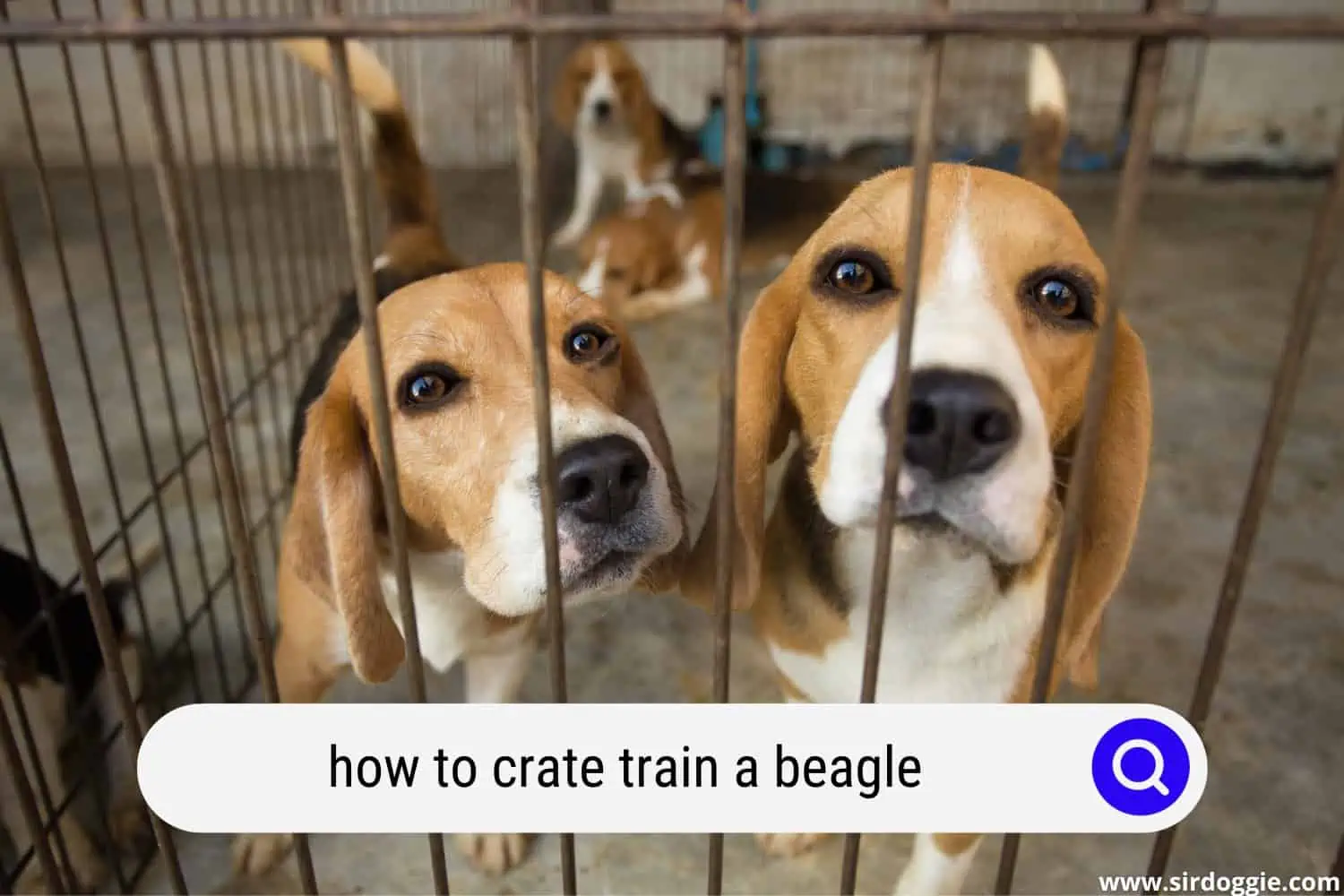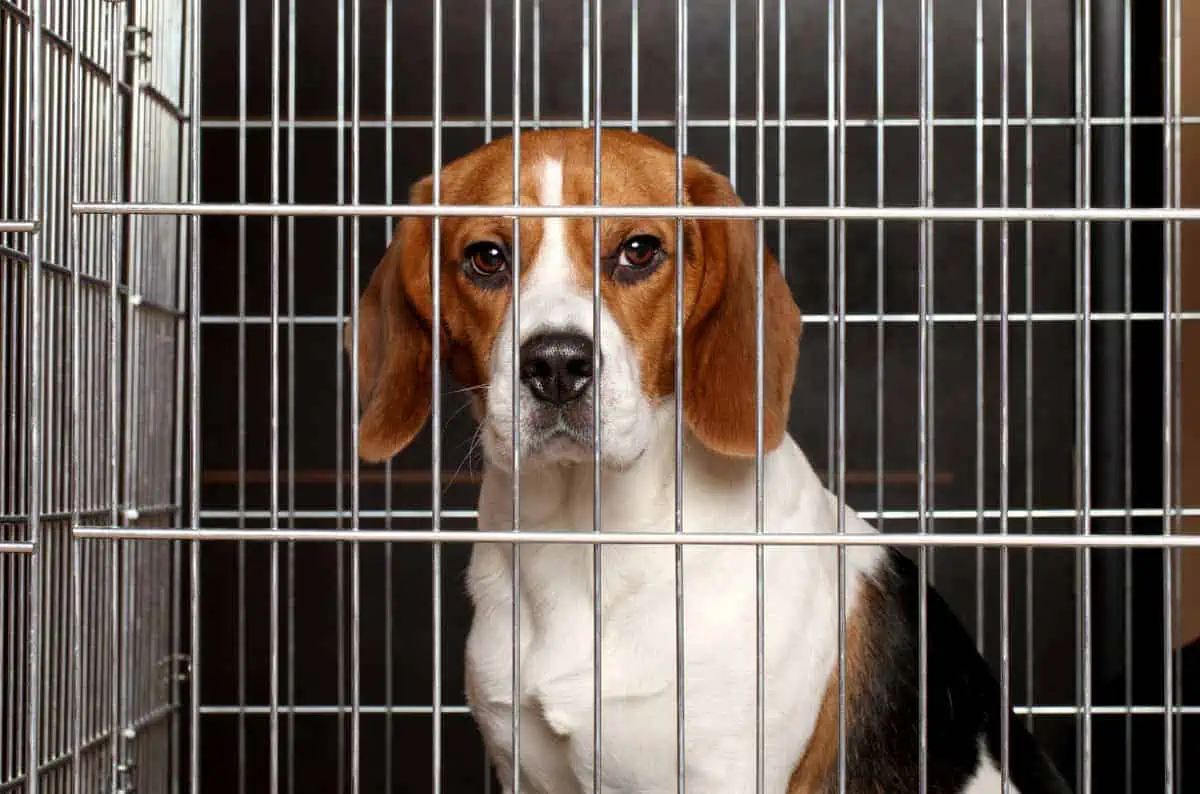How to Crate Train a Beagle
Do you want a well-behaved Beagle that doesn’t tear things up? Crate training provides dog owners greater peace of mind. It gives Beagles a sense of protection and safety. Your Beagle can enjoy the privacy and security of a den of its own.

Crate training is one of the least stressful ways to mold desirable behaviors in Beagles.
The good news is that Beagles are relatively easy to train. You need to understand and follow the Beagle crate training tips.
Some of the links in this post are affiliate, and we may earn a commission.
Related Reading: Top 3 Brushes for Beagles
The Crate Training Process for Beagles
It can take a few or many weeks to train your Beagle. This depends on your dog’s age, past experience, and temperament. Try to ensure that the crate is associated with something pleasant.
Let’s get down to the steps for crate training your Beagle. You can follow this series of small steps to avoid going too fast.
Step 1: Create a positive environment inside the crate
A crate should be a safe and comfortable place where your Beagle can relax and sleep. You need to ensure that your dog thinks the crate is a great place to be. For this, it is important that your dog likes the crate.
It is essential that your Beagle feels safe inside. Here’s what you can do to make the crate Beagle-friendly:
- Put a comfy bed inside the crate
- Keep your Beagle’s favorite toys inside the crate
- Put some delicious treats inside the crate
- Cover the crate with a blanket and make it a confined space
Step 2: Encourage your Beagle to go inside the crate
Once the crate is ready, it’s time to introduce it to your Beagle. Give your dog a treat just for being around the crate.
Keep the crate door open and let your Beagle examine it. If it goes inside the crate, reward your dog with praise and a treat. Do not force your dog to go inside the crate.
You can put a treat inside the crate and let your dog go inside and get that. Your dog should feel that the crate is a comfortable and rewarding place to be in.
Step 3: Establish a positive association with the crate
You should create positive associations with the crate through the use of treats and games. When they are inside the crate, they should have something that stimulates them.
Here’s what you can do to associate good things with the crate for your Beagle.
- You can play some crate games
- You can put a trail of treats leading to the crate
- You can throw the ball inside the crate and play fetch
All these will make the crate a part of your Beagle’s environment.
Step 4: Close the door for the first time
Once your Beagle gets comfortable with the crate, it’s time to close the door for the first time. Start by closing the door for five seconds so that the dog doesn’t get stressed.
Step 5: Increase the duration
Teach your Beagle how to stay inside when the door is closed. You will need to do this step when your dog is calm and tired. If he remains calm inside, close the door.
Here’s how you can do it:
- Put your hands inside the crate from the bars to make it less scary for your Beagle.
- Try to stay beside the crate so that your beagle feels safe.
- If your dog gets anxious, decrease the time to 5 seconds.
- If your dog remains calm for those 20 seconds, open the door and reward your furry pal with praise and treats.
Step 6: Step away from the crate
Once your Beagle feels comfortable inside the crate with closed doors, teach your dog to stay inside the crate in your absence.
- Send your Beagle inside the crate when your dog is calm and tired.
- Get up, take a few steps away from the crate, and return.
- Open the door and reward your dog with praises and treats.
- Increase the distance gradually and repeat until you can walk outside the door and come back.
- Start with stepping out of the room for a few seconds before your return.
Step 7: Let your Beagle out only when he is calm
Never encourage negative behaviors during training. You should make it clear to your Beagle that howling and excessive barking won’t work. If your dog is howling, do not open the door. Once it stops howling, go ahead and let it out. Your Beagle should understand that silence is the only way to get what he wants.

Tips for crate training your Beagle
Here are some tips that should help you to crate-train your Beagle:
Choose the right crate
The first step in crate training for your Beagle is choosing the right crate. Select a crate that is big enough to accommodate your Beagle.
It should be big enough that your adult dog can move freely inside. If the crate is very large, ensure that the extra space is blocked.
Establish the proper mindset
Your Beagle should associate the crate with a relaxed mindset. This will help them to ultimately enjoy hanging out there.
Crate feed your beagle
Once your Beagle is used to the crate, begin feeding meals near the crate and eventually in the crate. Close the door while your dog is eating. When your dog finishes eating, praise this behavior and then open the door. This will create positive associations with the crate.
Be consistent
Consistency can be a challenge but it is the key to successful Beagle crate training. Beagles are very adaptable and can be trained with the right level of patience and consistency.
You need to reinforce the moves of the Beagle training sessions. You should feed them in the crate and let them out of the crate at the same time.
Don’t respond to whining and crying
Be prepared to ignore whining and crying, and even to avoid entering the room when he’s making a noise. You want him to learn that quiet behavior is rewarded, not noise.
More time in the crate should do
Increase the amount of time your Beagle spends in the crate. To make it pleasant, ensure that you regularly give it treats as a form of encouragement. When your beagle is used to eating in the crate and doesn’t show signs of fear or anxiety, confine them in the crate for periods while you’re home. Give him a treat once he’s in the crate and a treat when you let him out.
Eventually, move the crate to its permanent site
Remember that the process of crate training your Beagle is one that often takes patience. Begin by placing the crate close to where you and your dog normally hang out to help boost its confidence in the process. Later, move it to the location you want to use as its permanent site.
Frequently Asked Questions
1. Can you crate a beagle?
Many dog parents refuse to crate their Beagles and feel the confinement is cruel. A crate can give your dog a sense of security. You can create your Beagle but not for a very long period of time.
2. How long can a beagle stay in a crate?
You can create a Beagle puppy for a maximum of 4 – 5 hours straight. Puppies should sleep in their crates at night, as this helps them learn to sleep through the night. Leaving a puppy alone in a crate while at work is unacceptable.
Adult Beagles can handle up to 8 hours of confinement, but it shouldn’t be a regular thing. Leaving your Beagle for more than 8 hours can hurt their mental and physical health.
3. Is it cruel to crate a Beagle as punishment?
Never use the crate as a punishment for your Beagle. Your furry pal will come to fear it and refuse to enter. Don’t leave your Beagle in the crate too long. A dog who’s crated for a longer period doesn’t get enough exercise or human interaction. Such dogs can become depressed or anxious.

Final thoughts
Beagles are creatures of habit. They learn by association. If your Beagle stays in the crate, you should reward your furry pal. Remember that the reward is linked to your dog’s action.
It should be given immediately, within a second or two. Both treats and praise will work for your Beagle. This increases the chances that your dog will learn crate training effectively.
Crate training your Beagle is a process and may take time and effort. You must ensure that you follow all the tips outlined in the article for crate training your Beagle.
Confining your beagle to a crate is certainly one of the best ways to have a rewarding life with your dog.

Family Dog Expert Author
Hi there! I’m Stuart, a devoted dog lover and family dog expert with over a decade of experience working with our furry companions. My passion for dogs drives me to share my knowledge and expertise, helping families build strong, loving bonds with their four-legged friends. When I’m not writing for SirDoggie, you’ll find me hiking, playing with my beautiful dog, or studying music.
